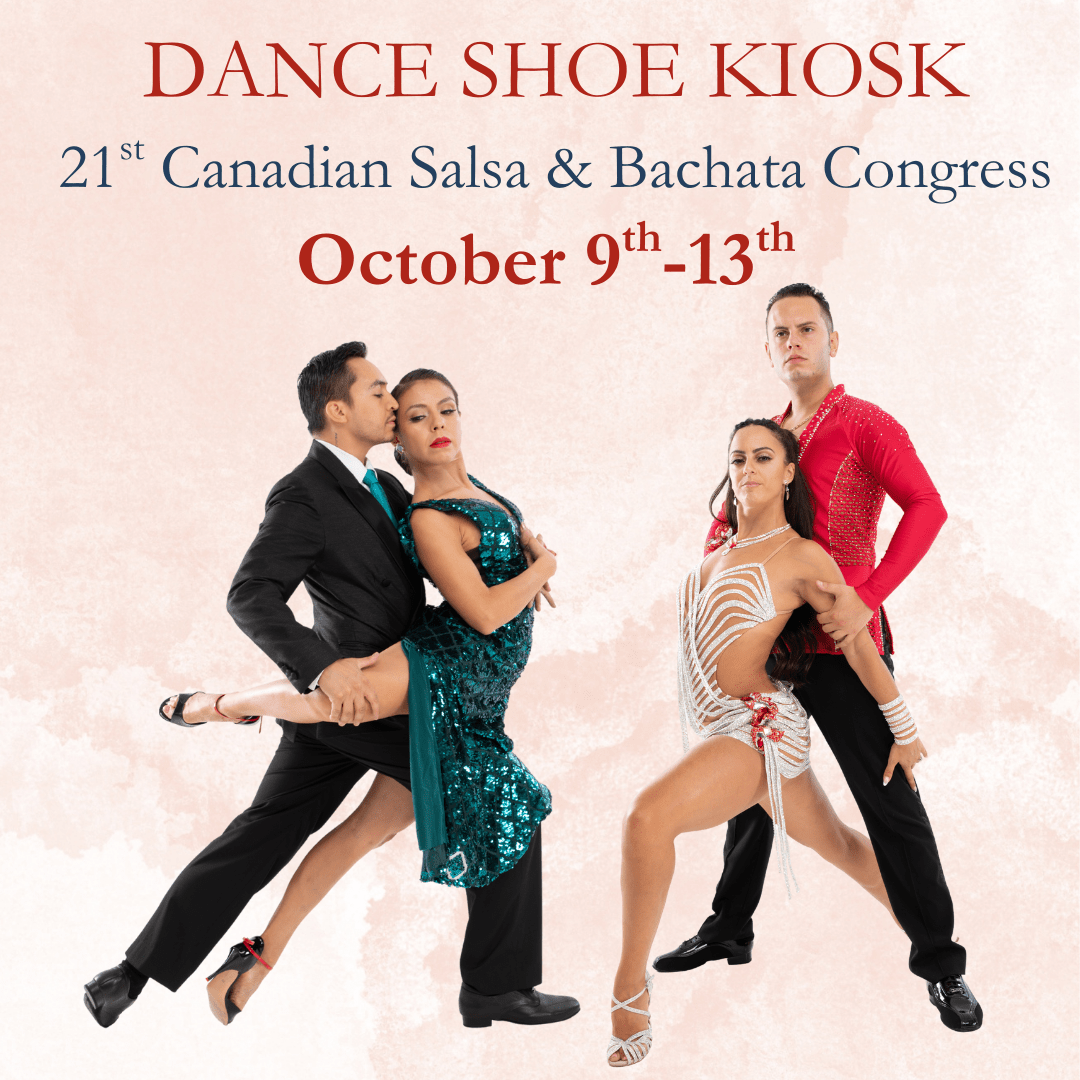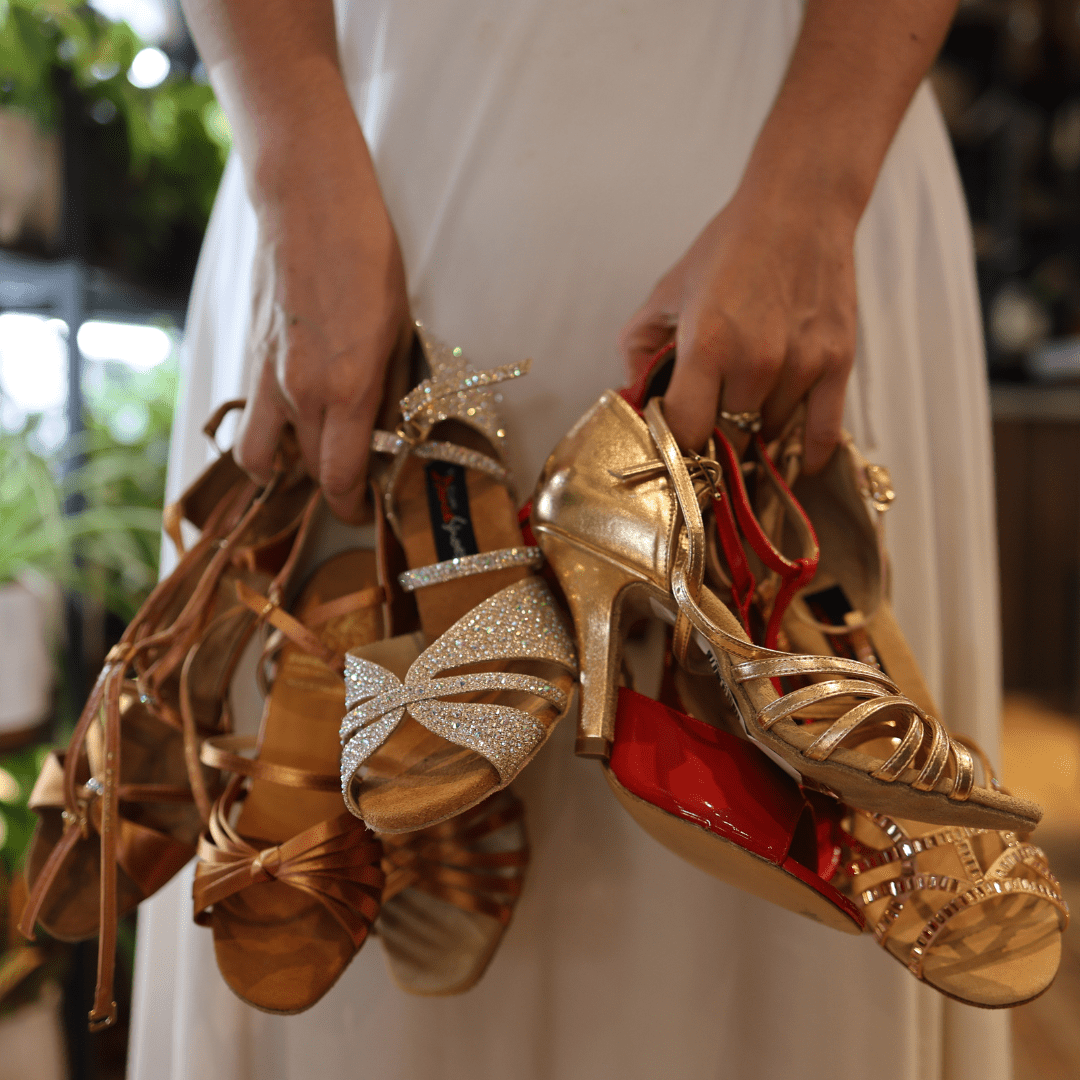Why do different shoes exist for different dances? Dance evolved alongside the music and traditions of different cultures, demanding different types of movement isolations, fluidity, athleticism, and connection to the floor. If we're not talking about aerial or water dances, most movement starts from the floor, and your dance footwear makes a huge difference. Different shoes have different functions, although it's not obvious at first and it can be overwhelming to decide which shoes to buy, or to wear, to what activity, in the face of so many options. This blog will break down types of shoes you’ll find in the dance world (specifically ballroom and latin dances) and their functions, for beginner dancers to competitive dancers. Here is how you should go about choosing the right pair of dance shoes for you based on your preferred dance style, level, activity, foot shape, and personal preference/style.
Dance style
Different style dances require different style shoes. For women, a major distinction is made between open-toe and closed-toe heels. Closed-toe heels are used for the standard (or ballroom) dances, such as the waltz, tango, and foxtrot for smooth dancing. They maintain the feminine arche and elegance while allowing for heel leads (initiating the movement with the heel of the foot and rolling through to the toe), smooth tow pivots and flawless spins. Open-toe heels are designed for latin dances such as samba, rumba, salsa and bachata. They have higher and thinner heels, and raised arches, as these styles are danced more on the ball of the feet and call for that iconic latin hip movement. Similarly for men, ballroom shoes are designed with a shorter, wider heel for a stable but elegant look, called standard heel, whereas mens latin shoes are designed with a steeper heel called cuban heel. Latin shoes often have thinner material and a split sole to offer more flexibility and facilitate weight changes and hip movement from the balls of the feet. Ballroom competitions are scheduled where all Standard dances are danced together and separate from the Rhythm dances so that the dancers can change outfits and shoes (and energies!) in between. iLoveDanceShoes specializes in Ballroom and Latin dances, but also offer options for jazz, heels, swing, and wedding dances. Other styles require their own unique footwear like ballet, tap, and various folk dances, which are best (and largely only available) to buy in stores specializing in those styles.
Standard closed-tow: Lily
Standard open-toe: Bacall
Mens latin with cuban heel: Pallene
Mens Ballroom/Standard: Thornton
Level
Dance shoes are not only for professional dancers! Even if you only dance a few times a year, it’s important for your feet to have that comfort and support to avoid injury. There are many reasons for this, one of the biggest is that dance shoes are made with suede soles, which allow for controlled grip and spin on the dance floor, whereas regular shoes tend to be either too slippery or too sticky, greatly increasing chances of slipping and falling or twisting your ankle or popping your knees. Dance shoes are also made to avoid blisters and other types of discomfort. When starting latin or ballroom, beginner dancers who are not at all used to wearing heels are better off starting with a much lower and thicker heel to build up those muscles to avoid injury. With experience, dancers often work their way up heel sizes as their technique and confidence improve. Another distinction in heels are flared heels (gets wider at the bottom) and slim heels (thin all the way down). Flared heels are generally more popular, as they give extra support but also look quite elegant, imitating a sext hourglass shape. Slim heels are more common in dances like tango for a chance to pierce your partner's body if they misbehave. Just kidding! Slim heels are an aesthetic preference that demands more precision and control. Our heel heights range from 1.5” to 4” (measured from the middle of the heel to the floor), and most of our models can be custom made to a heel type and height of your choice!

Custom heels offered at I Love Dance Shoes
Activity
Regardless of which style(s) you like to dance, different activities, whether it be taking classes, training, social dancing, performing or competing may call for different shoes. For taking classes and training, comfort and longevity is key. The very best option are practice shoes. These are specifically made with designs and materials that provide the same heel height flexibility that a performance shoe would offer, while enhanced comfort and durability. The main feature to look out for is flexibility. Some practice shoes have a split sole, which offers more flexibility, like a latin heel, while others are more rigid, which is good for ballroom. Someone with ankle problems might opt for this option as well. For competition and performance, only tan-colored heels with or without rhinestones are generally accepted. Just remember that while shiny is beautiful, it will attract attention to your feet in competition, which you might or might not want depending on the level of confidence in your own footwork. You also want your look to be clean, so it’s good to keep one pair of heels clean and the soles relatively fresh, and have another plain latin/ballroom pair to train in. The last type of activity is parties or social dancing, and this is where you have all the freedom! It’s fun to match your shoes with your outfit, but always opt for what makes you feel good. Practice shoes if you want to comfortably dance for hours on end, otherwise you can wear different colored heels, plain or sparkly, or dance boots!
Foot shape
Everyone's feet are different. No one model is perfect for everyone; different models will fit differently. For example, some people's toes might be scrunched up or stick out of open toe heels depending on how many straps there are and where they are placed. For people with specific feet problems like bunions, they might prefer models without straps, and opt for a peep-toe or closed toe. The width of your feet will also determine the best model for you. For example, some have a large open space in the front, while others have a small opening. A smaller opening is better for narrow feet, as they won't slide down the front. iLoveDanceShoes has some models that are wider than others, but any model can be custom made to fit wide or narrow feet! Finally, it’s important that you feel good. If you don’t like your feet and you feel uncomfortable having your toes exposed, go for a beautiful closed-toe heel! At iLoveDanceShoes, you can set an appointment to try on different models and see which models fit best to your feet. If you can’t come to Montreal, we might be coming to your city, in which case we’d let you know through out newsletter.

Examples of what different foot widths look like
Personal preference and style
So far we’ve discussed how to navigate the large shoe market to match your dance style, level, and feet shape for different activities, but you’ll notice there will still be many options to choose from. This is the fun part! You can choose the color and model that fits your personal preference and style (within your budget). Consider your personal preferences for the look of the model, the fit, and the material used. iLoveDanceShoes offers dozens of models in different tan shades, black, red, and other fun colors and patterns, with the options to customize a certain model with your preferred size, width, and heel, if needed. Navigate iLoveDanceShoes wide selection here.
Examples of different styles within iLoveDanceShoes open-toe heel collection
Thanks for reading, I hope this was a helpful guide to navigate the dance shoe world! As dancers expand their variety of dance activities, it can be very fun to expand their dance shoe collection. While there are many pretty shoes out there, remember that different shoes serve different functions, foot health is crucial, and comfort is key.
To ask questions, to set an appointment for your shoe fitting with I Love Dance Shoes in Montreal or to find out if and when we are coming to your city, call +1 (866) 520-6218 or send us an email at info@ilovedanceshoes.com, that’s what we are here for!
Author: Csenge Magyar
Contact: csenge@ilovedanceshoes.com +1 (866) 520-6218









